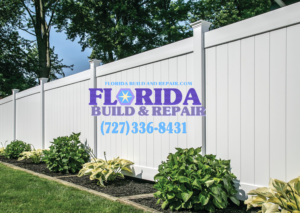Common Challenges in Naples Vinyl Privacy Fence Installation (And How to Fix Them)
Installing a vinyl privacy fence in Naples is straightforward with the right prep, but challenges can pop up—especially for DIYers. Here’s a rundown of the most common hurdles and how to tackle them like a pro, keeping your project on track.
1. Uneven or Sloped Terrain
- Challenge: Flat panels on a slope leave gaps underneath or look jagged. Vinyl doesn’t always flex like wood.
- Fix:
- Stepping: Drop each section lower to follow the grade. Measure the drop with a level and string for consistency—e.g., 6-inch steps per 8-foot panel. Cut posts to height after setting.
- Racking: Angle panels to match the slope if your kit allows (check manufacturer specs—some vinyl racks, some doesn’t). Test one section first.
- Pro Tip: Start at the lowest point and work up to avoid miscalculations.
2. Misaligned Posts
- Challenge: Posts that aren’t plumb (straight up and down) throw off rails and panels, making the fence wobbly or uneven.
- Fix:
- Set end posts first, then run a taut string line between them at bottom-rail height. Use a 4-foot level on every post—check side-to-side and front-to-back.
- Brace posts with stakes or scrap wood while concrete cures (24-48 hours). Don’t rush—wet concrete shifts.
- If a post sets crooked, dig it out, reposition, and re-pour before attaching panels.
3. Underground Obstacles (Roots, Rocks, Utilities)
- Challenge: Hitting tree roots, big stones, or unmarked lines slows digging and risks damage.
- Fix:
- Call 811 (in the US) to mark utilities—free and mandatory.
- For roots, use a sharp shovel or rent an auger ($50/day) to power through. Small rocks? Pry them out with a digging bar.
- Shift post locations slightly (e.g., 6 inches) if obstacles are immovable—just adjust panel spacing evenly.
4. Vinyl Cracking or Splitting
- Challenge: Hammering too hard or overtightening screws cracks panels or posts—vinyl’s less forgiving than wood.
- Fix:
- Use a rubber mallet, not a metal hammer, for tapping parts into place. Gentle taps only.
- Pre-drill holes for screws or brackets to avoid stripping. Tighten just enough—don’t crank it.
- Work in mild temps (40-80°F)—extreme cold makes vinyl brittle, heat makes it too soft.
5. Expansion and Contraction Issues
- Challenge: Vinyl expands in heat and shrinks in cold. Too-tight fits pop rails or crack panels over time.
- Fix:
- Leave gaps as per manufacturer instructions (usually 1/16 to 1/8 inch at connections). Use a spacer (like a scrap piece) for consistency.
- Install in moderate weather if possible—avoid mid-summer scorchers or deep winter freezes.
- Check after a season—loose parts can be snugged up, but don’t overdo it.
6. Concrete Setting Too Fast or Slow
- Challenge: Rushing before concrete hardens shifts posts; waiting too long drags out the job.
- Fix:
- Mix concrete to a thick-but-pourable consistency—too watery weakens it. Pour, level the post, and brace it.
- Wait 24-48 hours for full cure (check bag instructions). Hot weather? Mist it lightly to slow drying. Cold? Cover with a tarp.
- Work in sections—set a few posts, let them cure, then move on.
7. Inconsistent Panel Spacing or Gaps
- Challenge: Uneven post spacing leaves awkward gaps or forces panel cuts, which some kits don’t handle well.
- Fix:
- Measure your fence line and divide by panel length (6 or 8 feet) before digging. Mark exact post centers with stakes and string.
- Dry-fit a panel between posts before pouring concrete—adjust if off. Buy an extra panel for flexibility.
- If gaps persist, add vinyl trim or a bottom rail extension (sold separately).
8. Wind or Stability Worries
- Challenge: Tall vinyl fences catch wind—weak posts or shallow holes lead to leaning or snapping.
- Fix:
- Bury posts 2-3 feet deep (1/3 of fence height) with 4-6 inches of gravel for drainage, then concrete.
- In windy areas, use metal post inserts inside vinyl sleeves (check kit compatibility) or space posts closer (e.g., 6 feet vs. 8).
- Avoid solid panels in hurricane zones—opt for semi-privacy styles with slats.
9. Gate Installation Struggles
- Challenge: Gates sag or won’t latch if posts aren’t square or reinforced.
- Fix:
- Use heavier-duty posts (often sold separately) at gate points. Double-check plumb and square with a 3-4-5 triangle (3 feet one way, 4 the other, 5 diagonal).
- Install gate hardware per kit instructions—level the gate before tightening hinges.
- Add a diagonal brace or anti-sag kit if the gate’s wide or heavy.
10. Underestimating Time or Effort
- Challenge: Fatigue leads to sloppy work—crooked posts, loose panels, or skipped steps.
- Fix:
- Budget 1-2 days for 50-100 feet. Break it into phases (posts day 1, panels day 2).
- Grab a helper—lifting panels and holding posts is twice as fast with two.
- Rent tools (auger, long level) to cut grunt work.
Quick Prevention Tip
Plan ahead—check your kit’s manual, watch a few install videos, and map your layout. Most issues stem from winging it.
These fixes keep your Naples vinyl privacy fence solid and sharp. Hit a snag—like a steep hill or stubborn rock? Toss me the details, and I’ll tailor a solution!

Best Tools and Materials for a Smooth Vinyl Privacy Fence Installation in Naples
A smooth vinyl privacy fence installation in Naples hinges on having the right tools and materials—quality gear saves time, prevents headaches, and ensures a pro-grade

The Ultimate Naples Vinyl Privacy Fence Installation Checklist
Here’s the ultimate checklist for installing a vinyl privacy fence in Naples — a concise, step-by-step rundown to keep you organized and on track. Print

Common Challenges in Naples Vinyl Privacy Fence Installation (And How to Fix Them)
Installing a vinyl privacy fence in Naples is straightforward with the right prep, but challenges can pop up—especially for DIYers. Here’s a rundown of the

Naples Vinyl Privacy Fence Installation vs. Wood: Which Is Better?
Choosing between vinyl and wood for a Naples privacy fence comes down to your priorities—cost, maintenance, durability, looks, and installation effort. Here’s a head-to-head comparison

Is Naples Vinyl Privacy Fence Installation Right for You?
Deciding if Naples vinyl privacy fence installation is right for you depends on your needs, budget, skills, and property. Let’s break it down to see


